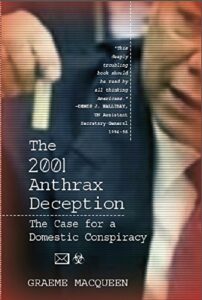The 2001 Anthrax Deception: The Case for a Domestic Conspiracy
TRANSCEND MEMBERS, ANGLO AMERICA, REVIEWS, LITERATURE, 8 Dec 2014
Edward Curtin - TRANSCEND Media Service
Review of [TRANSCEND Member] Graeme MacQueen’s Book
The anthrax attacks that followed those of 9/11 have disappeared from public memory in ways analogous to the pulverization of the Twin Towers and World Trade Center Building 7. For the towers, at least, ghostly afterimages persist, albeit fading like last night’s nightmare. But the anthrax attacks, clearly linked to 9/11 and the Patriot Act, are like lost letters, sent, but long forgotten. Such disappearing acts are a staple of American life these days. Memory has come upon hard times.
With The 2001 Anthrax Deception, Professor Graeme MacQueen, founding Director of the Center for Peace Studies at McMaster University, calls us back to a careful reconsideration of the anthrax attacks. It is an eloquent and pellucid lesson in inductive reasoning and deserves to stand with David Ray Griffin’s brilliant multi-volume dissection of the truth of that tragic September 11th. MacQueen makes a powerful case for the linkage of both events, a tie that binds both to insider elements deep within the U.S. government, perhaps in coordination with foreign elements.
MacQueen’s thesis is as follows: The criminal anthrax attacks were conducted by a group of conspirators deep within the U.S. government who are linked to, or identical with, the 9/11 perpetrators. Their purpose was to redefine the Cold War into the Global War on Terror and in doing so weaken civil liberties in the United States and attack other nations.
Obviously these are explosive charges that demand substantial evidence connected logically in a compelling thesis.
MacQueen, in countering anti-conspiratorial thinkers of the left and right who approach such issues with minds like beds already made up, explains his method thus: “The tools of investigation are no different from those used to test other proposals. We use evidence and reason. In some cases we will be able to make confident assertions and in other cases we shall have to acknowledge that we are speculating, but even in this second case we will do our best to ground our speculation in evidence. Ideology, national loyalty, outrage and ‘common sense’ will not do the job.”
There is no doubt that his thesis, backed up by abundant evidence and some intriguing speculation, is a conspiracy theory, just like the 9/11 Commission Report’s explanation of 9/11 and the Bush administration’s neo-con and media assisted conspiratorial tying of Saddam Hussein and Al Qaeda to 9/11 and the anthrax attacks. “We would have to look very hard to find anyone who does not hold a conspiracy theory about 9/11,” he writes. “And for this reason it is silly to denigrate people for holding a conspiracy theory about this event.”
But good theory of any kind necessitates facts to make it credible, and MacQueen provides a plethora of these, while the Bush administration made allegations and promises of evidence that was never delivered. He aptly quotes researcher Elias Davidsson ‘s evidentiary points concerning the 9/11 hijackers:
‘The following five classes of evidence should have been produced by U.S. authorities in September 2001 or shortly thereafter.
- Authenticated flight lists;
- Authenticated boarding cards;
- Authenticated security videos from the airports;
- Sworn testimonies of personnel who attended boarding of the aircraft;
- Formal identification of the bodies or bodily remains from the crash sites, including chain-of-custody reports.”
Not only does MacQueen provide copious documented facts to support his case, but he does it in a systematically logical way that leaves the official story in shambles. If a crime were being prosecuted (as it should, but war was waged instead), MacQueen marshals a case for conviction beyond a reasonable doubt.
The anthrax letter attacks began on September 18, 2001 when the first letters were mailed from Princeton, New Jersey. Between October 3 and November 20 twenty-two people were infected with dried anthrax spores and five died. Between October 6 and October 8 especially highly refined and aerosolized anthrax letters were sent to two key Democratic Senators, Thomas Daschle and Patrick Leahy. Before October 3 when the first case, that of Robert Stevens who died two days later, was diagnosed, the FBI claimed that “no one except the perpetrators knew…that the attacks were in progress.”
Yet The New York Times, between September 12 and October 3, made reference to the possibility of biological or chemical terrorist attacks 76 times, 27 references specifically to anthrax. Many of these warnings came from government leaders. Of course the Times was home to Judith Miller, notorious for her deceptions regarding Iraq’s WMD, and whose book Germs: Biological Weapons and America’s Secret War, was about to be published in the first few days in October. In that book Miller et al. assert that Iraq might use a terrorist group to unleash a bioweapon against the United States.
Just coincidentally, throughout the month of October as the anthrax attacks became public, the Bush administration and the mainstream media pushed the claim that Al Qaeda (already accused of 9/11) and Saddam Hussein (slyly implicated by innuendo) were responsible for the anthrax attacks. Once the U.S. started bombing Afghanistan on October 7, alleged Al Qaeda retaliation enhanced the claim. No evidence was presented. The Washington Post, vying with The New York Times for Cassadran bragging rights, had published a September 27 article “Al Qaeda May Have Crude Chemical Capabilities.” This double foreign group suggestion – that Bin Laden’s group, state-sponsored by Iraq, sent the anthrax spores – was promoted vigorously throughout October. The crude anthrax letters written to Tom Brokaw of NBC News and Senator Daschle with their 09-11-01 headings and Muslim extremist language, released to the public on October 23, seemed to clinch the case.
MacQueen writes,
“Much evidence suggests that this option was meant to carry the day and was central to the original plan. An attack on the U.S. by groups of foreign Muslims using weapons of mass destruction could clearly serve to legitimize internal repression, external aggression, and a host of ancillary transformations. This scenario was established in advance of the anthrax attacks and pushed hard in October 2001 as citizens got sick and died of anthrax, as the Patriot Act was pushed through Congress and the large scale NSA domestic spying was launched, as the invasion of Afghanistan began, and as preparations were made to invade Iraq.”
By October 26, once Bush had signed the Patriot Act, that case began falling apart, but not before the two Democratic Senators, Daschle and Leahy, who had resisted ramrodding the bill into law, had received their own lethal anthrax letters as possible reminders.
When R. W. Apple Jr. wrote a New York Times front page article on October 18, “City of Power, City of Fears,” and said, “the government has been caught completely by surprise by the anthrax attacks,” he may not have known about the exercise termed Dark Winter, conducted four months earlier on June 22-23, though one would think he might have known of the plethora of references to anthrax in his own paper in the few weeks before the attacks became known. Maybe he thought the Bush administration didn’t read the New York Times for intelligence.
MacQueen,in a greatly significant piece of sleuthing, however, lets us know about Dark Winter, a biological warfare simulation planned and conducted by Johns Hopkins Center for Civilian Biodefense Strategies/Center for Strategic and International Studies at Andrews Air Force Base with uncanny parallels to the actual anthrax attacks. Some oddities follow. Dark Winter had anonymous letters sent to the mainstream media with threats of anthrax. Dark Winter claimed that the perpetrators are probably state-sponsored international terrorists. Dark Winter claimed that “a prominent Iraqi defector is claiming Iraq arranged the bioweapons attacks on the U.S. through intermediaries.” Dark Winter concludes that the attacks necessitate harsh restrictions on civil liberties, possibly Martial Rule. Dark Winter has a fictional television anchor announce that “still no group claims responsibility for unleashing the smallpox virus, but NCR has learned that Iraq may have provided the technology behind the attack to terrorist groups based in Afghanistan.”
And yes, not to be missed, we learn that Dark Winter’s simulation’s actors included Apple’s New York Times’ colleague Judith Miller, soon to be the New York Times best- selling author of Germs, playing a reporter for the New York Times; James Woolsey, former CIA Director and supporter of The Project for the New America Century (we’ll need a new Pearl Harbor, folks); and Jerome Hauer,a member of the Committee on the Present Danger, and “an important figure in the linking of the 9/11 attacks and the anthrax attacks,” who played the FEMA director.
Once the government’s accusations against Al Qaeda and Iraq fell apart but the Patriot Act had become law, NSA spying commenced, and the war in Afghanistan proceeded apace, the FBI changed its tune and pursued the lone wolf perpetrator theory, first accusing a scientist named Steven Hatfill and then, after he sued and eventually received $5.82 million in compensation, they accused Bruce Ivins, a scientist working on an anthrax vaccine at Fort Derrick in Maryland. MacQueen shows in detail how that claim came apart and resulted in a case without credibility but with Ivins committing suicide. But, he concludes, the Ivins accusation served its purpose of diverting attention from the real reason for the anthrax attacks and its culprits.
Finally, MacQueen details how the anthrax evidence leads to some of the alleged 9/11 hijackers in Florida as they lay down a trail of incriminating “evidence” we were meant to follow, linking crop-dusters/anthrax to 9/11. Mohamed Atta, the alleged 9/11 ringleader, supposedly went into a U.S. Department of Agriculture office seeking a $650,000 loan to buy and enlarge a crop-duster. He made sure the agent knew and could spell his name, and when she balked at the loan, “he asked what would stop him from going around her desk, cutting her throat, and taking the money from the large safe in the office.” He then admired a photo of Washington, D.C., asked to buy it, inquired about security at the World Trade Center, implied he was associated with Al Qaeda, and told her that Bin Laden “ ‘would someday be known as the world’s greatest leader.’ “
MacQueen sardonically comments, “And that is the story of how a terrorist leader, engaged in a top-secret operation, sought a government loan to help him with his plan.”
For one familiar with Lee Harvey Oswald’s (or his double’s) antics to make himself unforgettable on visits to a car dealership and a rifle range before JFK’s assassination, the Atta charade should ring a bell. MacQueen makes a powerful case that the various crop-duster incidents were “disinformation” and that their purpose was to link 9/11 to the anthrax attacks and, notably, to Iraq. He notes that it was also at this time that the fictitious story of Atta meeting with an Iraqi intelligence agent in Prague was widely circulated to “solidify this connection.” He argues that once the FBI admitted that the anthrax attacks were not a foreign operation but the claim had served its purpose, the crop-duster stories vanished into obscurity. However, he concludes, “Given that the anthrax attacks were a domestic operation, and given that the alleged hijackers were implicated in that operation prior to its occurrence, the conclusion cannot be avoided: the 9/11 attacks were also a domestic operation.”
But as few can forget, on February 5, 2003 at the UN Security Council, the Iraq/anthrax/crop-duster claim arose from its sleep in the infamous, fraudulent presentation by Colin Powell as he slyly tied Iraq back to the anthrax attacks and shilled for war against Iraq. That feat of propaganda was but one of at least 532 occasions when eight top members of the Bush administration made at least 936 false statements on Iraq’s possession of weapons of mass destruction and its links to Al Qaeda, according to a study conducted by The Center for Public Integrity and the Fund for Independence in Journalism and released in 2008.
Anyone concerned about the truth behind 9/11 and the anthrax attacks should read this profoundly important book. It is filled with tight argumentation backed by solid evidence, and even the speculative parts ring true.
In closing I will mention MacQueen’s fascinating penultimate chapter wherein he speculates about the significance of the repeated word “unthinkable” by the media and government officials following George W. Bush’s use of the term “rethink the unthinkable” in a May 1, 2001 speech at the National Defense University. The mainstream media used the word “unthinkable” repetitively throughout October 2001 when referring to the anthrax attacks. And one of the early anthrax threatening letters sent to Tom Brokaw, begins: “The Unthinkabel” (sic) – showing, of course, how Muslim terrorists can’t spell English. “There is a pattern here,” MacQueen writes.
“The pattern may not signify a grand plan, or, indeed, conscious intent at all – there may be no conspiracy – but, whatever the origins of the ‘unthinkable’ discourse, it deserves investigation and contemplation.”
Words matter, and those repeated enough matter more, words such as ground zero, homeland, and unthinkable. “He who wants to persuade should not put his trust in the right argument,” Joseph
Conrad wrote in Lord Jim. “The power of sound has always been greater than the power of sense.”
MacQueen has chosen sense through argument, and rather than dismissing his as unthinkable, thinking people everywhere should engage it.
_______________________________
Prof. Graeme MacQueen is co-editor of the Journal of 9/11 Studies and co-author, with Johan Galtung, of Globalizing God-Religion, Spirituality and Peace, TRANSCEND University Press, 2008. MacQueen was founding director of the Centre for Peace Studies at the McMaster University in Hamilton, Ontario, where he taught for 30 years. He holds a Ph.D. in Buddhist Studies from Harvard University and is a member of the TRANSCEND Network for Peace Development Environment. MacQueen was an organizer of the Toronto Hearings on 9/11, is a member of the Consensus 9/11 Panel, and is a former co-editor of the Journal of 9/11 Studies.
 Edward Curtin is a writer whose work has appeared widely. He is a member of the TRANSCEND Network for Peace Development Environment. Website: Behind the Curtain
Edward Curtin is a writer whose work has appeared widely. He is a member of the TRANSCEND Network for Peace Development Environment. Website: Behind the Curtain
Tags: Conspiracy Theories, Fake News, False flag, Geopolitics, Hoax, Politics, Reviews, USA, Violence
This article originally appeared on Transcend Media Service (TMS) on 8 Dec 2014.
Anticopyright: Editorials and articles originated on TMS may be freely reprinted, disseminated, translated and used as background material, provided an acknowledgement and link to the source, TMS: The 2001 Anthrax Deception: The Case for a Domestic Conspiracy, is included. Thank you.
If you enjoyed this article, please donate to TMS to join the growing list of TMS Supporters.

This work is licensed under a CC BY-NC 4.0 License.
Read more
Click here to go to the current weekly digest or pick another article:
TRANSCEND MEMBERS:
- NATO's 5% of GDP Military Expenditures Is a 100% Indefensible and Stupid Idea
- Requisite Appreciation of "Bullshit"?
- Rwanda: Victoire Ingabire Must Not Suffer the Fate of Kizito Mihigo
ANGLO AMERICA:
- Washington Green-Lights $30M for Gaza Aid Scheme Tied to Mass Killings of Palestinians
- War with Iran: We Are Opening Pandora's Box
- Trump’s Useful Idiots
REVIEWS:
- MIT Science for Genocide
- We the People: Whistleblowers, Whistleblowing & Retaliation in the United Nations
- It’s Not You, It’s CAPITALISM
LITERATURE:

